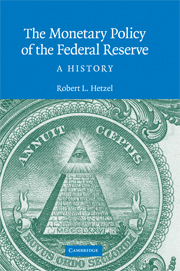Book contents
- Frontmatter
- Contents
- Figures
- Preface
- 1 The Pragmatic Evolution of the Monetary Standard
- 2 Learning and Policy Ambiguity
- 3 From Gold to Fiat Money
- 4 From World War II to the Accord
- 5 Martin and Lean-against-the-Wind
- 6 Inflation Is a Nonmonetary Phenomenon
- 7 The Start of the Great Inflation
- 8 Arthur Burns and Richard Nixon
- 9 Bretton Woods
- 10 Policy in the Ford Administration
- 11 Carter, Burns, and Miller
- 12 The Political Economy of Inflation
- 13 The Volcker Disinflation
- 14 Monetary Policy after the Disinflation
- 15 Greenspan's Move to Price Stability
- 16 International Bailouts and Moral Hazard
- 17 Monetary Policy Becomes Expansionary
- 18 Departing from the Standard Procedures
- 19 Boom and Bust: 1997 to 2001
- 20 Backing Off from Price Stability
- 21 The Volcker–Greenspan Regime
- 22 The Fed: Inflation Fighter or Inflation Creator?
- 23 The Stop–Go Laboratory
- 24 Stop–Go and Interest Rate Inertia
- 25 Monetary Nonneutrality in the Stop–Go Era
- 26 A Century of Monetary Experiments
- Appendix: Data Seen by FOMC for the Stop–Go Period Shown in Figures 24.1, 24.2, and 24.3
- Notes
- Bibliography
- Index
- Titles in the series
13 - The Volcker Disinflation
Published online by Cambridge University Press: 26 May 2010
- Frontmatter
- Contents
- Figures
- Preface
- 1 The Pragmatic Evolution of the Monetary Standard
- 2 Learning and Policy Ambiguity
- 3 From Gold to Fiat Money
- 4 From World War II to the Accord
- 5 Martin and Lean-against-the-Wind
- 6 Inflation Is a Nonmonetary Phenomenon
- 7 The Start of the Great Inflation
- 8 Arthur Burns and Richard Nixon
- 9 Bretton Woods
- 10 Policy in the Ford Administration
- 11 Carter, Burns, and Miller
- 12 The Political Economy of Inflation
- 13 The Volcker Disinflation
- 14 Monetary Policy after the Disinflation
- 15 Greenspan's Move to Price Stability
- 16 International Bailouts and Moral Hazard
- 17 Monetary Policy Becomes Expansionary
- 18 Departing from the Standard Procedures
- 19 Boom and Bust: 1997 to 2001
- 20 Backing Off from Price Stability
- 21 The Volcker–Greenspan Regime
- 22 The Fed: Inflation Fighter or Inflation Creator?
- 23 The Stop–Go Laboratory
- 24 Stop–Go and Interest Rate Inertia
- 25 Monetary Nonneutrality in the Stop–Go Era
- 26 A Century of Monetary Experiments
- Appendix: Data Seen by FOMC for the Stop–Go Period Shown in Figures 24.1, 24.2, and 24.3
- Notes
- Bibliography
- Index
- Titles in the series
Summary
The appointment of Paul Volcker as chairman of the Board of Governors on August 6, 1979, changed the policymaking environment of the Fed. Burns and Miller had taken the Fed on a detour away from Martin's belief that the Fed was responsible for inflation. Volcker made low inflation the objective of policy. Consistent with his early background in financial markets at the New York Fed and with his oversight of the Bretton Woods system at the treasury, Volcker focused on expectations. Moreover, he acted on the belief that credible monetary policy could shape those expectations.
With that belief, Volcker challenged Keynesian orthodoxy, which held that the “high” unemployment of the 1970s demonstrated that inflation arose from cost-push and supply shocks. Expectations in the form of a wage–price spiral propagated that inflation. Because of the nonmonetary origin and built-in propagation of inflation, an attempt to control it through monetary policy without incomes policies would create unacceptably high levels of unemployment. The rational expectations revolution became so only with the demonstrated success of the Volcker disinflation. The 1979 Joint Economic Report (U.S. Cong. March 22, 1979, 45) expressed the prevailing view:
Inflation … cannot be dealt with … through demand restriction alone without exacting intolerable costs in terms of lost output and high unemployment. … Clearly, demand restriction does not address supply-related inflation triggered by rising energy and food costs, increases in government regulation, substandard productivity gains, and a declining international value of the dollar – which is propelled onward by subsequent spirals of wages and prices attempting to keep up with each other.
- Type
- Chapter
- Information
- The Monetary Policy of the Federal ReserveA History, pp. 150 - 171Publisher: Cambridge University PressPrint publication year: 2008
- 1
- Cited by

